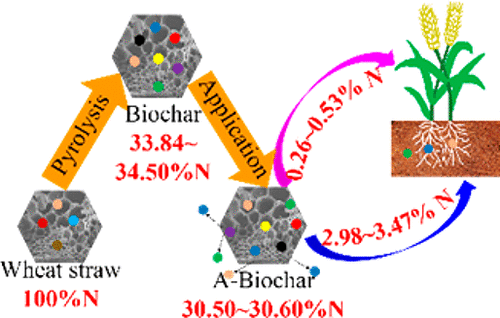当前位置:
X-MOL 学术
›
ACS Sustain. Chem. Eng.
›
论文详情
Our official English website, www.x-mol.net, welcomes your
feedback! (Note: you will need to create a separate account there.)
Transformation and Transport Mechanism of Nitrogenous Compounds in a Biochar “Preparation–Returning to the Field” Process Studied by Employing an Isotope Tracer Method
ACS Sustainable Chemistry & Engineering ( IF 7.1 ) Pub Date : 2018-01-19 00:00:00 , DOI: 10.1021/acssuschemeng.7b03172 Liyun Liu 1 , Zhongxin Tan 1 , Zhixiong Ye 1
ACS Sustainable Chemistry & Engineering ( IF 7.1 ) Pub Date : 2018-01-19 00:00:00 , DOI: 10.1021/acssuschemeng.7b03172 Liyun Liu 1 , Zhongxin Tan 1 , Zhixiong Ye 1
Affiliation

|
Due to biochar’s excellent physical and chemical properties, such as rich void ration and large specific surface area, it could improve soil by conserving water and fertilizer and providing breeding grounds for soil microorganisms. Therefore, it has been attracting researchers’ interests for its potential as a soil amendment. In this work, elemental analysis-stable isotope ratio mass spectrometry (EA-IRMS) and X-ray photoelectron spectroscopy (XPS) were conjointly employed to investigate the migration and transformation mechanism of biochar nitrogenous compounds in the “preparation–returning” process. EA-IRMS data indicated that during the preparation process the nitrogen retention rate in biochar first dropped sharply (300–400 °C), then became stable (400–500 °C), and finally decreased slowly (500–800 °C) with increasing pyrolysis temperature. After returning biochar to soil, the measurable total nitrogen in biochar that migrated to soil and plants displayed a nitrogen mass distribution rate in the order of biochar after returning (88.40–90.42%) > soil (8.81–10.07%) > plants (0.77–1.53%). In addition, the pyrolysis temperature was negatively related to the nitrogen mass distribution rate in biochar, soil, and wheat. On the other hand, the pyrolysis atmosphere had little effect on the nitrogen retention rate in biochar before returning and the nitrogen mass distribution rate in biochar after returning to the field. XPS results suggested that alkaloid-N, free amino acid-N, protein-N, and NH4+-N in wheat straw were gradually transformed into pyridine-N, amino-N, pyrrole-N, quaternary-N, NH4+-N, NO2–-N, and NO3–-N in biochar during the biomass pyrolysis process. Biochar produced at 300 °C was in a transition stage that included all nitrogenous compounds present in wheat straw as well as biochar produced at the lower temperatures (≤500 °C). At higher temperatures, inorganic nitrogen species were more abundant and displayed higher contents. For pyrolysis temperatures ≤500 °C, biochars prepared under both N2 and CO2 atmospheres comprised similar nitrogenous compounds and contents. Moreover, the changes in nitrogenous compounds and nitrogen release patterns during the process of returning biochar to the field were not significantly different.
中文翻译:

采用同位素示踪法研究生物炭“制备-返回田间”过程中含氮化合物的转化和迁移机理
由于生物炭具有优异的理化特性,如丰富的空隙率和较大的比表面积,可通过节约水和肥料并为土壤微生物提供繁殖地来改善土壤。因此,它作为土壤改良剂的潜力一直吸引着研究者的兴趣。在这项工作中,元素分析稳定同位素比率质谱法(EA-IRMS)和X射线光电子能谱法(XPS)联合用于研究生物炭含氮化合物在“制备—返回”过程中的迁移和转化机理。EA-IRMS数据表明,在制备过程中,生物炭中的氮保留率首先急剧下降(300–400°C),然后稳定(400–500°C),最后缓慢下降(500–800°C)。增加热解温度。将生物炭返回土壤后,迁移到土壤和植物中的生物炭中可测量的总氮在返回(88.40–90.42%)>土壤(8.81–10.07%)>植物(0.77– 1.53%)。另外,热解温度与生物炭,土壤和小麦中氮的质量分布速率负相关。另一方面,热解气氛对返回前的生物炭中的氮保留率和返回田后的生物炭中的氮质量分布率的影响很小。XPS结果表明,生物碱-N,游离氨基酸-N,蛋白质-N和NH 40–90.42%)>土壤(8.81–10.07%)>植物(0.77–1.53%)。另外,热解温度与生物炭,土壤和小麦中氮的质量分布速率负相关。另一方面,热解气氛对返回之前的生物炭中的氮保留率和返回田后的生物炭中的氮质量分布率的影响很小。XPS结果表明,生物碱-N,游离氨基酸-N,蛋白质-N和NH 40–90.42%)>土壤(8.81–10.07%)>植物(0.77–1.53%)。另外,热解温度与生物炭,土壤和小麦中氮的质量分布速率负相关。另一方面,热解气氛对返回之前的生物炭中的氮保留率和返回田后的生物炭中的氮质量分布率的影响很小。XPS结果表明,生物碱-N,游离氨基酸-N,蛋白质-N和NH在生物量过程中,麦草中的4 + -N逐渐转化为生物炭中的吡啶-N,氨基-N,吡咯-N,季铵盐,NH 4 + -N,NO 2 -- N和NO 3 -- N。热解过程。在300°C下产生的生物炭处于过渡阶段,其中包括小麦秸秆中存在的所有含氮化合物,以及在较低温度(≤500°C)下产生的生物炭。在较高的温度下,无机氮种类更加丰富,并且含量更高。对于≤500°C的热解温度,在N 2和CO 2两种条件下制备生物炭大气中包含相似的含氮化合物和内容物。此外,在将生物炭返回田间过程中,含氮化合物的变化和氮释放模式没有显着差异。
更新日期:2018-01-19
中文翻译:

采用同位素示踪法研究生物炭“制备-返回田间”过程中含氮化合物的转化和迁移机理
由于生物炭具有优异的理化特性,如丰富的空隙率和较大的比表面积,可通过节约水和肥料并为土壤微生物提供繁殖地来改善土壤。因此,它作为土壤改良剂的潜力一直吸引着研究者的兴趣。在这项工作中,元素分析稳定同位素比率质谱法(EA-IRMS)和X射线光电子能谱法(XPS)联合用于研究生物炭含氮化合物在“制备—返回”过程中的迁移和转化机理。EA-IRMS数据表明,在制备过程中,生物炭中的氮保留率首先急剧下降(300–400°C),然后稳定(400–500°C),最后缓慢下降(500–800°C)。增加热解温度。将生物炭返回土壤后,迁移到土壤和植物中的生物炭中可测量的总氮在返回(88.40–90.42%)>土壤(8.81–10.07%)>植物(0.77– 1.53%)。另外,热解温度与生物炭,土壤和小麦中氮的质量分布速率负相关。另一方面,热解气氛对返回前的生物炭中的氮保留率和返回田后的生物炭中的氮质量分布率的影响很小。XPS结果表明,生物碱-N,游离氨基酸-N,蛋白质-N和NH 40–90.42%)>土壤(8.81–10.07%)>植物(0.77–1.53%)。另外,热解温度与生物炭,土壤和小麦中氮的质量分布速率负相关。另一方面,热解气氛对返回之前的生物炭中的氮保留率和返回田后的生物炭中的氮质量分布率的影响很小。XPS结果表明,生物碱-N,游离氨基酸-N,蛋白质-N和NH 40–90.42%)>土壤(8.81–10.07%)>植物(0.77–1.53%)。另外,热解温度与生物炭,土壤和小麦中氮的质量分布速率负相关。另一方面,热解气氛对返回之前的生物炭中的氮保留率和返回田后的生物炭中的氮质量分布率的影响很小。XPS结果表明,生物碱-N,游离氨基酸-N,蛋白质-N和NH在生物量过程中,麦草中的4 + -N逐渐转化为生物炭中的吡啶-N,氨基-N,吡咯-N,季铵盐,NH 4 + -N,NO 2 -- N和NO 3 -- N。热解过程。在300°C下产生的生物炭处于过渡阶段,其中包括小麦秸秆中存在的所有含氮化合物,以及在较低温度(≤500°C)下产生的生物炭。在较高的温度下,无机氮种类更加丰富,并且含量更高。对于≤500°C的热解温度,在N 2和CO 2两种条件下制备生物炭大气中包含相似的含氮化合物和内容物。此外,在将生物炭返回田间过程中,含氮化合物的变化和氮释放模式没有显着差异。











































 京公网安备 11010802027423号
京公网安备 11010802027423号